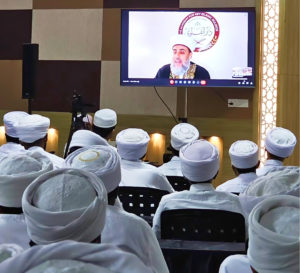There are five (5) prayers which must be performed by the Muslims and are called “obligatory” prayers. They are Dhuhr (Noon) prayer, ^Asr (afternoon) prayer, Maghrib (sunset) prayer, ^Ishaa’ (Nightfall) prayer and Fajr (Dawn) prayer. It is a great sin to neglect performing any of these obligatory prayers. Among the merits of performing the obligatory prayers is that one’s small sins, which may be committed between prayers, are forgiven. The Prophet , may Allah raise his rank, said what means:
“Whoever makes a complete wudu’, his sins will depart his body, until they leave from under his nails” (Muslim
How to Perform the Dhuhr (Noon) Prayer
The Dhuhr Prayer is four rak^ahs
1. Facing the Qiblah: It is obligatory to stand directing your chest to the honorable Qiblah. The Qiblah is the Ka ^ bah in Makkah.
2. Intention: It is obligatory to intend in your heart performing the obligatory Dhuhr prayer. Do that while saying Allahu akbar (God is great).
An example is to say in your heart “I intend to pray the obligatory Dhuhr prayer”.
3. The Opening Takbir: It is obligatory to say Allahu akbar at least as loud as you can hear yourself, while raising your hands next to your ears. Raising your hands is a recommended part.
4. Standing: It is obligatory to stand in the obligatory prayer when able. It is recommended to hold the wrist of the left hand with the right hand, placing both above the navel.
5. Reciting the Fatihah: It is obligatory to recite the Fatihah (the first chapter of the Qur’an) at least as loud as you can hear yourself. It is an obligation to recite the Fatihah properly, that is, to pronounce all the letters correctly. Learn the recitation of the Fatihah from a qualified teacher.
Whoever cannot recite the Fatihah correctly must recite other parts of the Qur’an, the number of letters of which should be at least equal to that of the Fajihah (156 letters). If one knows one or more ayahs of the Fatihah, one may repeat them as many times as would render minimally the same number of letters in the Fatihah. If one cannot recite any ayah of the Fatihah, one recites other ayahs of the Qur’an the letters of which add up to at least the same number of letters of the Fatihah. If one cannot recite any part of the Qur’an, one must recite certain words of dhikr, such as subhanallah, al-hamdulillah, la ilaha illallah, and Allahu akbar (I declare that Allah is clear of all imperfections, praise and thanks to Allah, no one is God but Allah, and Allah is the Greatest) as many times as would render minimally the same number of letters in the Fatihah (Ibn Hibban an-Nawawiyy):
For example, reciting Allahu akbar twenty times is sufficient. In the unusual case of someone being unable to recite the Fatihah, other parts of the Qur’an, or dhikr statements one stands as long as reciting the Fatihah with moderate speed takes.
It is recommended to say ءامين Amin (0 Allah, fulfill my request) after finishing the Fatihah, and to recite at least one verse from another chapter of the Qur’an in the first and second rak ah.
It is also recommended before reciting the Fajihah in the first cycle to say the Tawajjuh supplication and then the isti adhah (asking for Allah’s protection from the cursed devil).
6. The Ruku^” (Bowing): It is obligatory to bend at the waist until your palms can reach your knees and stay still in this position for at least the time it takes to say
سبحان الله subhanallah.
It is recommended upon bending to raise your hands next to your ears and say Allahu akbar. Also it is recommended while in ruku^, to say three times: سُبحانَ رَبِّيَ العظيم subhana Rabbiyal- ^Adhim (Praise be to my Great Lord).
7. The I^ tidal (Straightening up): It is obligatory to straighten your back and stay still in this position for at least the time it takes to say subhanallah. It is recommended while raising your trunk to raise your hands next to your ears and to say
سَمعَ اللهُ لِمَنْ حَمِدَهُ sami^ allahu liman hamidah (Allah hears who praises Him). While your back is straight up it is recommended to say رَبّنَا لَكَ الحَمدُ Rabbana lakal-hamd (0 our Lord, to You the praise is due).
8. The Sujiud (Prostration): It is obligatory to go down to the floor and prostrate by pressing your bare forehead, and putting your palms, knees, and pads of the toes on the floor. Both feet are kept vertical with the heels up and the toepads down touching the floor. Stay still in this position for at least the time it takes to say subhanallah.
It is recommended upon going down to the floor to raise your hands next to your ears and to say Allahu akbar.
Also it is recommended while in sujud to say three times subhana Rabbiyal-‘a la (Praise be to my Supreme Lord).
It is also recommended while in sujud to place your hands next to your shoulders, having your fingers together directed towards the Qiblah.
It is recommended for the male to keep his elbows away from his sides in his sujud and in his ruku^, and to keep his abdomen lifted away from his thighs in his sujud. However, the female keeps her elbows pulled in to her sides in her sujud and ruku and keeps her trunk close to her thighs in her sujud.
9. The Sitting between the two Sujuds: It is obligatory to raise your trunk from prostration and sit, staying still in this position for at least the time it takes to say subhanallah.
It is recommended to say Allahu akbar while coming to sitting.
Also, it is recommended while sitting to say:
Rabbighfir li warhamni wajburni warfa ^ ^ni warzuqni wahdini wa ^afini (0 my Lord, forgive me, have mercy on me, fulfill my needs, raise me, provide for me, guide me, and protect me from sickness).
It is also recommended to do the sitting with the left foot tucked under the buttocks while the right foot is kept vertical as in sujud.
An alternate recommended way of sitting is to rest the buttocks on the heels of both feet which are kept as in sujud.
It is recommended that the hands be placed on the thighs at the knees with the fingers extended and spread slightly towards the Qiblah.
10. It is obligatory to perform a second sujud from your sitting position. This sujud is similar to the first sujud.
After the second sujud is fulfilled you have completed the first rak^ah (cycle) of the prayer.
11. It is obligatory to stand up for the second rak^ah . It is recommended while doing so to say Allahu akbar. Repeat steps 5 to 10. This ends your second rak^ah .
12. It is recommended at this time to sit up from sujud, recite the Tashahhud, and say Allahumma salli ^ala Muhammad at least as loud as you can hear yourself.
It is recommended to sit with the feet as in step 9. An alternate way of sitting is to rest the buttocks on both crossed feet. It is also recommended to keep both hands on your thighs. The fingertips of your left hand should be spread towards your knee. In this sitting, the fingers of the right hand are lightly fisted except for the index finger which is extended slightly down. The index finger is lifted slightly at saying إلاّ الله illallah (in the Tashahhud) and is kept as such until the end of this sitting.
13. It is obligatory to stand up and do two more rak^ahs in the same way that you did from steps 5 to 11. It is recommended while rising for the third rak ^ah to raise your hands next to your ears and say Allahu akbar. However, raising the hands is not recommended while rising for the fourth rak^ah .
14. Upon completion of the second sujud of the last rak^ah, it is obligatory to sit up, recite the Tashahhud, and say Allahumma salli ^ala Muhammad.
It is recommended to keep the hands as in step 12. However, after the index finger is lifted slightly at saying illallah it is kept as such until the end of the prayer.
For this sitting it is also recommended to pass the left foot past the right leg and place the buttocks on the floor, keeping the right foot as in sujud.
Afterwards, it is recommended to say the Ibrahimiyyah. Then it is recommended to say a supplication such as:
Rabbana atina fid-dunya hasanah, wa fil- ‘akhirati hasanah, wa qina ^adhaban-nar, which means: “0 our Lord, grant us in this life and in the Hereafter good things, and protect us from the torture of the Hellfire”.
15. The Ending Salam: It is obligatory to say as¬salamu ^alaykum at least as loud as you can hear yourself. It is recommended to say as-salamu ^alaykum wa Rahmatullah first to one’s right and then to one’s left.
By saying this your Dhuhr prayer is ended.
How to Perform the ^Asr (Mid-afternoon) and ^Isha’ (Nightfall) Prayers
The ^Asr and ^Isha’ prayers are performed exactly as the Dhuhr prayer. However, in step 2 you intend the obligatory ^Asr prayer for the ^Asr prayer and the obligatory ^Isha’ prayer for the ^Isha’ prayer.
Moreover, it is recommended to recite the Qur’an in a louder manner in the first two rak^ahs “ of the ^Isha’ prayer.
How to Perform the Maghrib (Sunset) Prayer
The three rak^ahs ^ of the Maghrib prayer are performed exactly as the first three rak^ahs of ^Isha’. After the second sujud of the third rak^ah it is obligatory to sit up and do steps 14 and 15.
How to Perform the Subh or Fajr (Dawn) Prayer
The two rak^ahs “ of the Fajr (or Subh) prayer are performed exactly like the first two rak^ahs of the ^Isha’ prayer, but with the intention of performing the obligatory Fajr (or Subh) prayer.
After the second sujud of the second rak^ah ^ , do steps 14 and 15. Also after saying Rabbana lakal-hamd in the I^tidal (step 7) of the second rak^ah ^ , it is recommended to say the Qunut supplication at least as loud as you can hear yourself.





